|
|
Design
Suggestions for Easy Maintenance
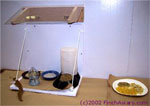 The
Plexiglas shield above the feeding station keeps
droppings from soiling the food and is easily
cleaned with vinegar and water. The feeding
station is easily accessible from one of the
center doors.
The
Plexiglas shield above the feeding station keeps
droppings from soiling the food and is easily
cleaned with vinegar and water. The feeding
station is easily accessible from one of the
center doors. |
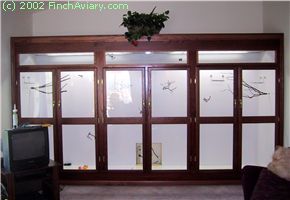
The use of plexiglas and tall baseboards keeps
debris inside the aviary. Because the entire
front is made of doors, all parts of the aviary
are easily accessible for cleaning. |
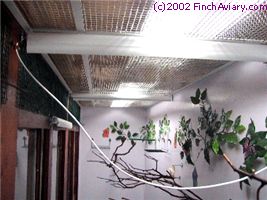 Mounting
shades to divide the aviary into sections keeps
the birds out while you clean.
Mounting
shades to divide the aviary into sections keeps
the birds out while you clean. |
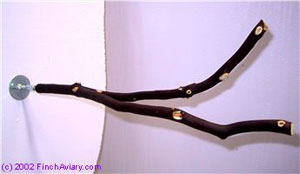 Manzanita
perches are easy to clean because of their smooth
surface. They are usually sold with a screw
mount so they can easily be removed for intensive
cleaning or disinfecting if necessary.
Manzanita
perches are easy to clean because of their smooth
surface. They are usually sold with a screw
mount so they can easily be removed for intensive
cleaning or disinfecting if necessary. |
|
If
you are in the process of designing an aviary, you may want
to keep in mind the following suggestions. These ideas may
help minimize the time spent maintaining the aviary so you
have more free time to enjoy it. Of course you have to weigh
the costs and benefits of each item in order to create the
aviary environment that is right for you and your birds.
-
Design the aviary with a baseboard that is several inches
above the floor level. This will help reduce the amount
of seed, hulls, food particles, feathers, nesting material,
bedding/litter, etc, that will leak from the aviary. NOTE:
Some debris will likely still leak, particularly feathers,
which tend to float up in the air when the doors are opened.
Some people suggest misting the feathers with water before
opening aviary doors so that they don't fly up in the air.
This is only possible if you can spray through a mesh ventilation
panel. Also, very tall baseboards will also limit your ability
to view the birds on the floor.
- Design
the aviary using Plexiglas instead of mesh. The Plexiglas
will not allow debris to pass out of the aviary and into
your house. Mesh ventilation panels will still be necessary
for proper airflow, but design the aviary such that the
ventilation panels are up at least midway from the floor,
where most of the debris will accumulate.
- If
using Plexiglas, design the aviary such that if a piece
of Plexiglas becomes damaged, it can be replaced without
too much hassle. Plexiglas can crack or become scratched
(remember, paper towels will scratch Plexiglas over time
- use soft cloths such as dishtowels instead). It can also
fog over time, especially if not cleaned with the appropriate
cleaners.
- Use
smooth slick surfaces on the inside of the aviary. Rough
or grooved surfaces allow droppings and particles to become
wedged inside. A lot of scrubbing may be required to get
these surfaces clean. Painting wood surfaces with a semi-gloss
or glossy finish latex paint will make it easier to clean
droppings off the surface.
- Design
the aviary such that all parts of the aviary are easily
accessible for cleaning. If the aviary will not be a walk-in
aviary, make sure that all parts of the aviary are accessible
via the door(s).
- Install
shades or other dividers to partition your aviary to keep
the birds out of the area you are cleaning, so they will
not interrupt you as you work and are less likely to escape.
- Place
the food/water dispensers in a location that is easily accessible.
Designing a special door down low used to swap food/water
in and out may be useful, although it is probably not necessary
as long as your aviary is not overcrowded since the birds
are not likely to try and escape unless provoked. However,
such a door may be a nice convenience if you ever need to
have someone else maintain your aviary for a few days. They
will probably feel more secure opening a small door than
a full-sized one. Alternatively, install a shade in front
of the door that can be pulled down when the food/water
needs to be changed.
- Be
sure to leave the area above the food and water free of
perches so that they will not become soiled from above.
Or, install a feeding station with an easy-to-clean shield
above it.
- Do
not stuff nesting material such as Excelsior into the back
wall of the aviary as was done with the first aviary we
owned. Although it looks nice, if you ever needed to disinfect
the entire aviary, it would be difficult to do so without
replacing all that nesting material. Also, the birds will
tend to pull out nesting material to make little holes they
can then nest in. These holes are very difficult to keep
clean. When we destroyed our old aviary, we found the back
wall behind the nesting material to be filthy with droppings.
If you choose this route, design the back wall such that
you can easily remove and replace this nesting material
and clean behind it.
- Put
the aviary lights on a timer so you don't have to worry
about remembering to turn on and off the lights at the same
time each day. If possible, leave one light on slightly
longer than the rest so the birds have enough light to find
their way to their sleeping spots before being submerged
in darkness. Or keep a red light or a night light on throughout
the night.
- Use
manzanita perches. Manzanita perches are natural branch
perches, so your birds will benefit from the variation in
shape and thickness. But they are also a very smooth wood
and very easy to clean. If you want to include natural perches
with a rougher surface as well (ie, for nail health), place
these perches higher up or in other locations where they
are not as likely to be soiled with droppings.
- Don't
overcrowd your aviary with perches - be sure to leave enough
space between perches to allow flight. Leave some space
above the perches (flight zone) so that the birds can fly
from one end to the other without interruption. Attempt
to place the perches such that one perch does not get soiled
because it is directly beneath another. Remember, the birds
will generally prefer the higher perches, so placing most
of the perches high up at the same level is preferred. Some
lower perches are useful if you have injured birds or young
birds who do not yet fly well. They will help these birds
reach the higher perches. Note that petshop birds who have
never had the opportunity for real flight may need these
lower perches as well as they build up strength to reach
the higher perches.
- Use
silk/plastic plants and vines sparingly. A lot of time can
be spent scrubbing droppings off of silk leaves. Place these
items up high and in out-of-the-way places, where birds
cannot perch above and soil them. You may want to consider
decorating portions of the outside of the aviary with plants
(real or silk), since they cannot be soiled but will still
give the aviary a more natural, "living" look
and may provide some cover and privacy for the birds. When
selecting fake greenery, remember that smooth plastic leaves
will be easier to clean than cloth leaves.
- Select
accessories such as seed hoppers and water dispensers with
smooth surfaces (the first set of seed hoppers/water dispensers
I used had a rough textured base, making it difficult to
scrub droppings off cleanly). Plastic accessories are easier
to clean and disinfect than are wood accessories. Select
accessories that can be easily cleaned and sanitized in
a dishwasher.
- Although
I believe that using paper on the bottom of the aviary is
the safest choice, litter/bedding could be used instead
to eliminate the need to change the paper on a daily basis.
If you go this route, be sure to choose a safe litter. Aspen
bedding or bedding from recycled newspaper is frequently
recommended. Pine or cedar is usually best avoided because
of the aromas emitted when wet. Corn cob is prone to mold
growth. Remember, however, the bedding may spill out of
the aviary over time.
- Purchase
an extra set of utensils and accessories so that one can
be in use in the aviary while the other is removed for cleaning.
- Use
disposable products when possible and not cost-prohibitive.
For example, serving fresh food on a disposable paper/plastic
plate will mean less clean up at the end of the day.
- Avoid
the use of stick and bamboo nestboxes if possible. These
nestboxes are very difficult to clean, as the poop becomes
wedged in all the cracks and crevices. Plastic box nestboxes
can be easily cleaned in the dishwasher. Or, use wooden
box nestboxes with a cardboard box insert. The cardboard
box can be disposed of when it becomes too dirty and replaced
with a fresh one.
- Consider
the use of a seed hopper that is designed to catch and recycle
spilt seed. In addition to saving money by reducing waste,
there will be less rubble collecting on the floor and less
debris to leak from the aviary. I have not yet found one
that will work in my aviary and that is large enough to
support more than a few birds. A nice (but very expensive
one) can be found at Bird-Zerk.com.
Although I have not tried it, I have heard good things about
it.
Click
Previous to return to the Time Commitment page | Click Next
for some Design Suggestions for advice in maintaining a Non-Breeding
Aviary
PREVIOUS
 |
|  NEXT
NEXT
 TOP TOP
|
|
|
How
do you care for your birds?

Vote
in our survey or view the results!
|
|
| |
See
Also:
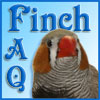
For answers to some
commonly asked questions!
|
|
|






